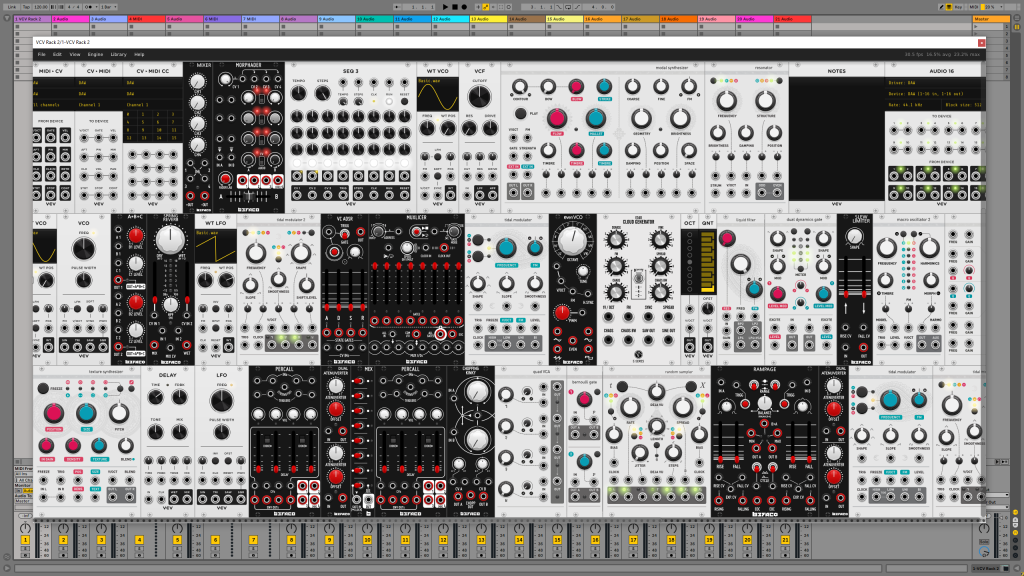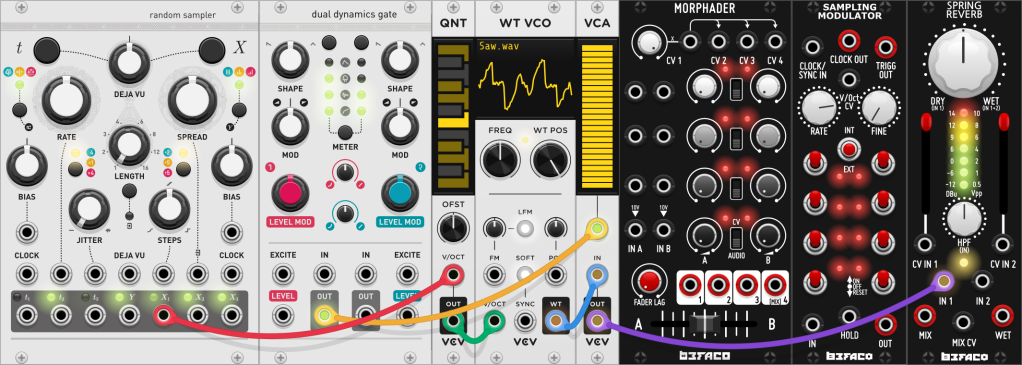The anticipated VCV Rack 2 is here and out of beta. What will it support? What does the release mean for compatibility with modules? What will it cost if you opt for the ‘Pro’ version? All the details here – but yeah, you can finally run VCV Rack inside your DAW.
I feel bad for any developers over the last two years – Rack moved so fast, so early that the two years of development of v2 likely felt artificially slow by comparison. And then these last two years felt like an absolute eternity in general for, uh, other reasons. But it’s here – mostly. Let’s get into it:
New features, vastly improved UI
Plug-in support for DAWs is a big part of what folks were waiting for. But VCV Rack 2 isn’t just about that addition. The new release – including the standalone version, which remains open-source – also has a ton of new features, with a whole bunch of UI improvements.
Plus the all-important, very pretty dark mode – see below. (Yes, I was schooled that this in fact had been available via modules, but having a stable host implementation is a big deal, and I still say it sure looks purty.)
VCV Rack 2 Free and Pro released [VCV > News]
I previewed this version earlier this fall:
But now we get the final feature list for VCV Rack 2 release. (I’ve also heard a lot of enthusiastic feedback from the folks who did install the beta.)
Dark room mode to save your eyes at night with adjustable room brightness.
Module selections to save, share, edit, and move around selections of modules. (New
.vcvsselection format.)Enhanced module browser to zoom, favorite, and sort your module collection.
Redesigned UI and built-in modules.
Port tooltips, context menu, and key commands for faster control of patch cables.
Optimized real-time engine with multiple audio interface support (if supported by manufacturers’ drivers).
Add/remove individual modules from the VCV Library to fine-tune your module collection.
See all 100+ new features in Rack’s changelog.
By the way, let’s specifically give a callout to PYER, the designer who did the UI overhaul. They’ve been doing a whole lot of my favorite UI work lately, I notice, unbeknownst to me, just as I peruse their portfolio:
https://www.pyer.be/portfolio.html

I just got the final build, so this is not a review. But I at least see some stuff that’s promising. Some more to highlight from the changelog, just for starters – updates to Core modules (the ones labeled “VCV” and included with the build) are significant, especially for anyone trying to teach workshops and use those fundamentals:
Add Audio-2 module with stereo input/output, a level knob, and VU meters.
Add DC blocker setting to Audio modules. On Audio-2, enable it by default.
Add MPE mode to MIDI-CC and MIDI-Gate.
Add mode to MIDI-CC to process 14-bit MIDI CC via MSB/LSB.
Use MIDI timestamps in MIDI-CV, MIDI-CC, MIDI-Gate, and MIDI-Map to improve overall timing and drastically reduce clock jitter.
Add red clip lights to VCV Audio-8/16 when signal reaches beyond ±10V.
Reset notes in MIDI-CV and MIDI-Gate if an “all notes off” MIDI message is received.
Allow disabling smoothing for MIDI-CV (pitch and mod wheel), MIDI-CC, and MIDI-Map.
Add several module presets for many Core modules.
Plug-in support, Pro, and platforms
Rack now includes a plug-in version so you can use it inside your DAW. That is possible with a number of other environments (even with Pd these days, if you’re ambitious), so it’s welcome here – I know it matters to workflow.
The bad news is, at launch Rack 2 is available Intel-native, and with VST2 plug-in support. There’s no support yet for other plug-in formats, though that’s promised “real soon now” and evidently will be covered by your Pro license when it’s available.
There’s also no M1 native version of either the standalone or the plug-in. That becomes a little tougher with only VST2 support, because with only an Intel VST2 plug-in, you have to run the entire DAW host in Rosetta. (The AU version would run in Rosetta inside the M1-native host, as I wrote about in regards to Ableton Live 11.1 beta. )
So there’s still a little more waiting for some folks. (On Windows, and for at least some hosts on Intel Macs, VST2 is just fine. You can also run an M1-native host like Bitwig Studio 4.1 using its built-in support for Rosetta VST2, as noted in comments.)
The good news is, that plug-in has robust features:
Save patches inside your DAW project.
Instrument/effect plugin.
Up to 16 audio input/output channels:
Process vocals, guitar, etc. with Rack as an effect plugin.
Perform Rack as an instrument plugin with 8 stereo (or 16 mono) outputs.
Send recorded or live DAW tracks directly into Rack using 8 stereo (or 16 mono) “sidechain” inputs.
16 MIDI input/output channels:
Generate MIDI for other DAW tracks with Rack’s sequencer modules.
Record and play back notes, gates, and CV with MIDI clips in your DAW.
Parameter automation of up to 1024 knobs, sliders, and buttons in your patch so you can record, play back, and tweak your modular performance.
Multiple instances with low processing overhead.
Offline rendering when exporting your project mixdown or pre-rendering tracks.
Resizable plugin window.
Andrew tells us they do plan to explain audio/MIDI routing to and from Rack; I’ll also look at whether I can help you all a bit with that topic.
The free/standalone version of Rack still works well and might be all you need.
If you do want plug-in support – and to help support VCV development in the process – the Pro version will be US$99 at launch through the end of this year. That price will then go up to US$149 regular pricing.
There’s also a bundle of Rack 2 Pro plus VCV Drums plus VCV Sound Stage for US$139 – probably the one I’d get – before it goes up to $209 in 2022.
Sound Stage is a fascinating 3D simulation reverb.
Drums is a nice selection of drum modules, in collaboration with the creator of the Vult series. I wrote about its release, as well.

What modules work; how to retain backward compatibility
All of VCV’s own labeled modules will work at launch.
Some 1500 total modules, including third-party modules, are available today, too, in the Library. A lot more should follow shortly – I’ve been watching as a lot of developers have enthusiastically embraced the new release. (There’s good reason for that, too, as I’ll explain in the next section.)
That won’t cover everything, though, so I do suggest that you keep a copy of Rack 1 (or 0.x if you’re really old-school), so you don’t break any old patches or lose any modules.
Rack 1 and Rack 2 can be installed side by side – they use different install locations, different user folders, and different plug-in installations.
There’s reason to put some effort into updating, though:
Stable audio engine performance
The biggest issue I have with Rack v1 – and it can seriously be a deal-killer – is its approach to performance. So that’s what I’m most eager to test – honestly, irrespective of having a plug-in version. There are some major engine changes that start to make Rack worth a more serious look.
So while you probably won’t hear this on Facebook groups and other buzz, this may be the single most important line in the entire changelog:
Improve engine performance and latency by no longer requiring thread synchronization between the engine thread and audio thread. The engine now runs directly on the audio thread.
That was a huge issue with Rack up until now – and I think also means there’s no sense in open source projects working with an engine pre-v2. Apologies to Andrew, but yeah, FFS this is about time. That thread sync issue would make Rack sort of inexplicably drift in weird ways or even cause little audio dropouts, an issue other environments don’t really have.
You don’t really need to be a developer or understand this; it’s just generally good news and the first thing I’ll try to test.
I love the stuff Rack module creators have done, some of which is just not available anywhere else – much as I love Pd, Reaktor, Voltage Modular, Reason, and so on, and I do use those, too. So I’ve been waiting for this, as have a lot of people. You can record audio and bring it into my DAW, so you don’t absolutely need the plug-in thing, but this you do need.
There are some other encouraging changes also related to stability:
Add “Master module” context menu item to VCV Audio modules to select which audio device clocks the engine.
Allow other modules to be the primary module, such as VCV Recorder for rendering audio faster than real-time.
Add setters/getters for nearly every instance variable in Rack’s API. Use these for higher likelihood of stability.
Overhaul Engine threading model to allow as many Engine methods to be called simultaneously as possible, while ensuring that Module events are mutually exclusive to module processing.
Praise be to the buffers. Yes.
(Don’t worry if you didn’t get any of that, just trust me – and yeah, I’ll be testing it and will report back.)
Videos
Some testers have been busy even with the beta, so there are some nice videos made with the prerelease builds. This may differ slightly from today’s launch build, but if you want to check them out:
Just a basic patch – not a sound demo, but shows you the workflow:
Parallel filters and dark mode:
Anyway, you can try the standalone version out for free – and the plug-in version I’ll be testing right away (including in Rosetta on the M1 Macs)
Sure, I have time to properly devote to VCV Rack, Reaktor Blocks, Pd, SuperCollider, Reason, Voltage Modular, Softube Modular, Bespoke, Unreal Engine, that new stuff in Bitwig Studio, Max for Live, and whatever else I’m forgetting at the moment. Let’s watch what happens.
But yeah, it’s dark, so let’s make dark ambient music in the dark mode of VCV Rack 2 while we sit in the dark, darkly.